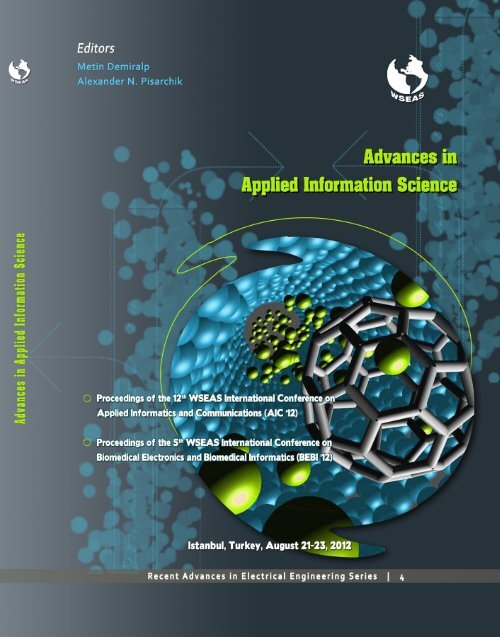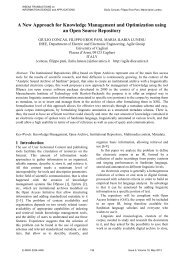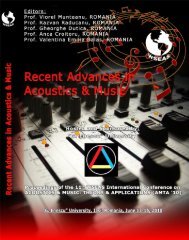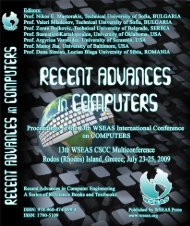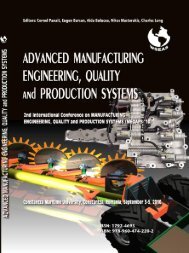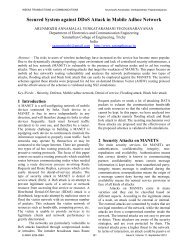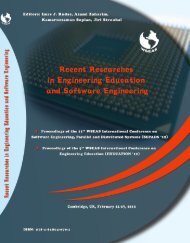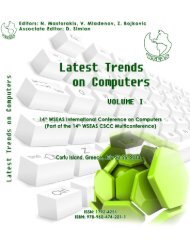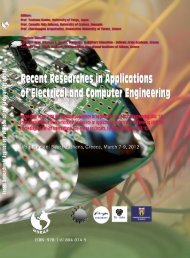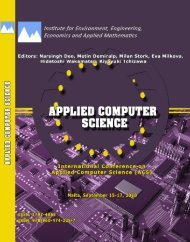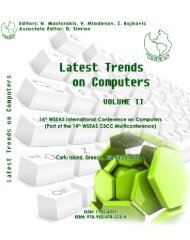ADVANCES in APPLIED INFORMATION SCIENCE - WSEAS
ADVANCES in APPLIED INFORMATION SCIENCE - WSEAS
ADVANCES in APPLIED INFORMATION SCIENCE - WSEAS
You also want an ePaper? Increase the reach of your titles
YUMPU automatically turns print PDFs into web optimized ePapers that Google loves.
<strong>ADVANCES</strong> <strong>in</strong> <strong>APPLIED</strong><strong>INFORMATION</strong> <strong>SCIENCE</strong>Proceed<strong>in</strong>gs of the 12th <strong>WSEAS</strong> International Conference on AppliedInformatics and Communications (AIC '12)Proceed<strong>in</strong>gs of the 5th <strong>WSEAS</strong> International Conference onBiomedical Electronics and Biomedical Informatics (BEBI '12)Istanbul, TurkeyAugust 21-23, 2012Recent Advances <strong>in</strong> Electrical Eng<strong>in</strong>eer<strong>in</strong>g Series | 4Published by <strong>WSEAS</strong> Presswww.wseas.orgISSN: 1790-5117ISBN: 978-1-61804-113-5
<strong>ADVANCES</strong> <strong>in</strong> <strong>APPLIED</strong><strong>INFORMATION</strong> <strong>SCIENCE</strong>Proceed<strong>in</strong>gs of the 12th <strong>WSEAS</strong> International Conference on AppliedInformatics and Communications (AIC '12)Proceed<strong>in</strong>gs of the 5th <strong>WSEAS</strong> International Conference onBiomedical Electronics and Biomedical Informatics (BEBI '12)Istanbul, TurkeyAugust 21-23, 2012Published by <strong>WSEAS</strong> Presswww.wseas.orgCopyright © 2012, by <strong>WSEAS</strong> PressAll the copyright of the present book belongs to the World Scientific and Eng<strong>in</strong>eer<strong>in</strong>g Academy andSociety Press. All rights reserved. No part of this publication may be reproduced, stored <strong>in</strong> a retrievalsystem, or transmitted <strong>in</strong> any form or by any means, electronic, mechanical, photocopy<strong>in</strong>g, record<strong>in</strong>g, orotherwise, without the prior written permission of the Editor of World Scientific and Eng<strong>in</strong>eer<strong>in</strong>g Academyand Society Press.All papers of the present volume were peer reviewed by no less that two <strong>in</strong>dependent reviewers.Acceptance was granted when both reviewers' recommendations were positive.See also: http://www.worldses.org/review/<strong>in</strong>dex.htmlISSN: 1790-5117ISBN: 978-1-61804-113-5World Scientific and Eng<strong>in</strong>eer<strong>in</strong>g Academy and Society
Editors:Prof. Met<strong>in</strong> Demiralp, Istanbul Technical University, TurkeyProf. Alexander N. Pisarchik, Centro de Investigaciones en Óptica, MexicoInternational Program Committee Members:Kev<strong>in</strong> Kam Fung YuenAndrea PirasElena ZaitsevaMuhammad Musaddique Ali RafiqueYuq<strong>in</strong>g ZhouJohn AntonopoulosPetr HajekTiberiu SocaciuYong Kheng GohClaudiu MereutaPavel VarachaYoshiyuki TohnoDaniela Crist<strong>in</strong>a MometeMansooreh Shariatmadare TehraniEleazar Jimenez SerranoGabriel BadescuJosip MusicHongjun LiuOzlem CoskunPhotios Ann<strong>in</strong>osKumaravelPanagiotis GioannisDzenana DonkoAnastasios SalisDaniela LitanS. Sarala SubramaniMirela-Catr<strong>in</strong>el VoicuZakaria ZubiHung-Jen YangMohammad Al-AmriSk. Sarif HassanHumberto VarumClaudia A. F. AiubTsvetel<strong>in</strong>a DraganovaArun SharmaZulkefli MansorJosé MetrôlhoM<strong>in</strong>g-Shen JianAna-Cornelia BadeaJose Alberto Duarte MollerManjunath KN KNSvetla VassilevaÁlvaro SantosOn<strong>in</strong>tra PoobrasertZengshi ChenConstant<strong>in</strong>o Mart<strong>in</strong>sVimala Ch<strong>in</strong>narajCarla P<strong>in</strong>toMd. Jakir HossenIvan PogarcicKyunghee LeeYi-Chao WuAw Yoke ChengBaritz MihaelaMihai Timis, MihaiCor<strong>in</strong>a CarrancaHowe H<strong>in</strong>g Tang Coll<strong>in</strong>Marcio DornSerban Cor<strong>in</strong>aGiovanni AielloSatish Kumar DuraiswamyWalid OueslatiEleonora CatsigerasKrishnaveni MarimuthuMahboobeh MahmoodiRomana IshratEustache Muteba AyumbaInácio FonsecaParesh RathodSeong Baeg KimDana AndersonYuLung WuV<strong>in</strong>od DSCarlos Rivas-EcheverriaMiroslav VoznakAntigona TroforChunwei, Lu W<strong>in</strong>i LuKh<strong>in</strong> Wee LaiStoican MirelaAlexander N. PisarchikCal<strong>in</strong> CiufudeanHime AguiarThaweesak Y<strong>in</strong>gthawornsukYang ZhangAnkit PatelWan Hussa<strong>in</strong> Wan IshakLarion Al<strong>in</strong>Jerzy RespondekJa<strong>in</strong>Sh<strong>in</strong>g WuKostant<strong>in</strong>os KalovrektisManuela PanoiuGabriela MirceaMd. Shamim AkhterHugo Cruz-SuarezElena BautuTheodoros XanthosMart<strong>in</strong> SkutilMontri PhothisonothaiVijay Kumar GPedro NucciYu ZhangNikos LoukerisLukas KourilDhaval VyasAlejandro Fuentes-PennaSor<strong>in</strong>el OprisanValent<strong>in</strong>a E. BalasAbdel-Badeeh Salem
PrefaceThis year the 12th <strong>WSEAS</strong> International Conference on Applied Informatics andCommunications (AIC '12) and the 5th <strong>WSEAS</strong> International Conference on BiomedicalElectronics and Biomedical Informatics (BEBI '12) were held <strong>in</strong> Istanbul, Turkey, August 21-23,2012. The conferences provided a platform to discuss applied <strong>in</strong>formatics, system architecture,operat<strong>in</strong>g systems, data bases, optical computers, microprocessors, broadband networks,communications, applied electromagnetics, computer networks, military communications,biomedical circuits, neural eng<strong>in</strong>eer<strong>in</strong>g, biomaterials, biomechanics, medical imag<strong>in</strong>g etc. withparticipants from all over the world, both from academia and from <strong>in</strong>dustry.Their success is reflected <strong>in</strong> the papers received, with participants com<strong>in</strong>g from several countries,allow<strong>in</strong>g a real mult<strong>in</strong>ational multicultural exchange of experiences and ideas.The accepted papers of these conferences are published <strong>in</strong> this Book that will be sent to<strong>in</strong>ternational <strong>in</strong>dexes. They will be also available <strong>in</strong> the E-Library of the <strong>WSEAS</strong>. Extendedversions of the best papers will be promoted to many Journals for further evaluation.Conferences such as these can only succeed as a team effort, so the Editors want to thank theInternational Scientific Committee and the Reviewers for their excellent work <strong>in</strong> review<strong>in</strong>g thepapers as well as their <strong>in</strong>valuable <strong>in</strong>put and advice.The Editors
Advances <strong>in</strong> Applied Information ScienceTable of ContentsPlenary Lecture 1: Language Technologies – Theories and Applications 13Velislava StoykovaPlenary Lecture 2: Comparative Study and Simulations for Classic and Advanced Models of theElectric ArcManuela PanoiuPlenary Lecture 3: On Improved Model<strong>in</strong>g of Survivability-Supported Traffic Eng<strong>in</strong>eer<strong>in</strong>g <strong>in</strong>Multi-Service NetworksDimitris Karras1415Plenary Lecture 4: eHealth Record vs Personal Privacy: Benefits and Concerns 16Dimitrios XanthidisPlenary Lecture 5: Nonl<strong>in</strong>ear Track<strong>in</strong>g: The Approach Based on Extended Kalman-Like UFIRFilter<strong>in</strong>gYuriy S. ShmaliyPlenary Lecture 6: Energy & Environmental Problems Fac<strong>in</strong>g the Third World and TheirProbable SolutionsD. P. KothariPlenary Lecture 7: Biomedical Informatics; New Insights <strong>in</strong> Next Generation of Cl<strong>in</strong>ical andBasic Human Biological SciencesBabak Khalili HadadPlenary Lecture 8: Extremely Low Frequency Magnetic Field Effects on Nerve ConductionVelocity, Depolarization Amplitude and Latency on Nerve Action PotentialSelcuk Comlekci17181920Plenary Lecture 9: F<strong>in</strong>ite Element Analysis of Teeth Restored with Ceramic Crowns 21Liliana SanduPlenary Lecture 10: Survey the Effect of Probiotic Doogh as a Bio-functional Medic<strong>in</strong>e 22Khashayar TabariPlenary Lecture 11: A New Invention Process of Manufactur<strong>in</strong>g a Softgel Capsule Probiotics asPre-Healthy Medic<strong>in</strong>eMahsa Tabari23Plenary Lecture 12: Cloud Comput<strong>in</strong>g and its Impact on the Healthcare Industry 24Nasseh TabriziExtremely Low Frequency Magnetic Field Effects on Nerve Conduction Velocity, DepolarizationAmplitude and Latency on Nerve Action PotentialOzlem Coskun, Selcuk Comlekci25ISBN: 978-1-61804-113-5 9
Advances <strong>in</strong> Applied Information ScienceFibre-Optic Interferometry as a Means for the First Heart Sound Detection 30Damjan Zazula, Denis Đonlagić, Sebastijan ŠpragerClassification of People Us<strong>in</strong>g Eye-Bl<strong>in</strong>k Based EOG Peak Analysis 36Andrews Samraj, Thomas Abraham, Nikos MastorakisThe Feasibility of Us<strong>in</strong>g High Amplitude Pulsed Ultrasound for Comb<strong>in</strong>ed Hard Tissue and SoftTissues Imag<strong>in</strong>gJohari Kasim, Imamul Muttak<strong>in</strong>, Mokhtar Harun, Camallil Omar, Eko Supriyanto, Razali IsmailNeuroscience Approach for Mathematics Ability Analysis among Cultural Differences Us<strong>in</strong>gFunctional Magnetic Resonance Image (fMRI)Nurul Fazrena Kamal, Nor Saradatul Akmar Zulkifli, Mohd Fauzi OthmanInteractions of 5-Iodotubercid<strong>in</strong> with B<strong>in</strong>d<strong>in</strong>g Site Of Ser<strong>in</strong>e/Threon<strong>in</strong>e - Prote<strong>in</strong> K<strong>in</strong>ase Hasp<strong>in</strong>;An ONIOM Approach StudyBabak Khalili Hadad, Hadis Soltani Sadeh, Foroozan Arman, Fatemeh Esmaeilzadeh424854Heat Pressed Ceramics Crowns with and without Zirconia Framework – A Biomechanical Study 63Liliana Sandu, Flor<strong>in</strong> Topală, Sor<strong>in</strong> PorojanAnalysis of the Reasons and Causes of Reduc<strong>in</strong>g Average Length of Stay <strong>in</strong> Healthcare Facilities<strong>in</strong> Selected OECD CountriesZuzana Tučková, Šárka FialováEffect of Preparation Height on Stress Distribution <strong>in</strong> Premolars Restored with Pressed CeramicCrownsSor<strong>in</strong> Porojan, Liliana Sandu, Flor<strong>in</strong> TopalăMathematical and Physical Modell<strong>in</strong>g of the Dynamic Electrical Impedance Both of a HealthyNeuron and one Affected by Park<strong>in</strong>son’s DiseaseGeorgios GiannoukosA Review: Fundamental and Applications of Functional Magnetic Resonance Imag<strong>in</strong>g (fMRI) onBra<strong>in</strong> Learn<strong>in</strong>g ActivitiesNor Saradatul Akmar Zulkifli, Nurul Fazrena Kamal, Mohd Fauzi Othman69757985Visual Representation of Bulgarian Adjectives Inflectional Morphology 91Velislava StoykovaDesign of Sequence Diagrams for Implementation of a Didactic Software used <strong>in</strong> the Study ofB<strong>in</strong>ary TreesAnca Iordan, Manuela Panoiu, Ionel Muscalagiu, Raluca Rob97UPSS: A Tool for Synthesiz<strong>in</strong>g UML Concurrent Communication Protocol Entities 103Jehad Al DallalIntroduc<strong>in</strong>g Scrum <strong>in</strong>to the Development of a News Portal 109Viljan MahnicISBN: 978-1-61804-113-5 10
Advances <strong>in</strong> Applied Information ScienceInformation Visualization on the Base of Hierarchical Graph Models 115V. N. KasyanovThe Use of the GIS for Mapp<strong>in</strong>g Hazard, Risk and Vulnerability with<strong>in</strong> Population Shelter<strong>in</strong>g 121Rak Jakub, Jurikova LucieCognitive Effectiveness of Prompts on Paper-Based and Display-Based Learn<strong>in</strong>g of SPI (Aptitude 127Test) Knowledge by AgeHaruhisa Yamaguchi, Yumi YamaguchiMeasurement of the Heart Rate of a Person dur<strong>in</strong>g Physical Activities 133Sevcik David, Jakub RakThe Use of the GIS for Population Shelter<strong>in</strong>g – A Case Study of the Use of Spatial Analyses 137Rak Jakub, Jurikova Lucie, Sevcik DavidA Proposal of Access-based Contents Recommendation <strong>in</strong> Virtual Database Environment on P2PNetworkTakuya Sasaki, Jun Sawamoto, Hiroyuki Sato, Norihisa Segawa, Eiji Sug<strong>in</strong>o, Yuji WadaThe Effects of Prompts on Paper-Based and Mobile Display-Based Learn<strong>in</strong>g of TechnologicalKnowledge by School AgeHaruhisa Yamaguchi, Yumi Yamaguchi142148Model<strong>in</strong>g and Simulation of the 5-Axis Robot Arm Trajectory 154Simona Sofia Duicu, Lum<strong>in</strong>ita PopaA Data M<strong>in</strong><strong>in</strong>g Survey on Identify<strong>in</strong>g the Factors that Influence Teachers’ View of the Romanian 160Educational SystemAngel-Alex Hăisan, Vasile Paul BresfeleanModel<strong>in</strong>g Distributed Active Database Us<strong>in</strong>g CTPN 166Bulbul Mukherjee, Ranjan DasguptaUsage of Cluster Analysis <strong>in</strong> Consumer Behavior Research 172Pavel Turc<strong>in</strong>ek, Jiri Stastny, Arnost MotyckaApply<strong>in</strong>g Data M<strong>in</strong><strong>in</strong>g to Compare Predicted and Real Success of Secondary School Students 178Lule Ahmedi, Eliot Bytyçi, Blerim Rexha, Valon RaçaBus<strong>in</strong>ess Model<strong>in</strong>g Based on Agents Systems Modules 182Yousef Moradi, Somayeh Rafiee, Am<strong>in</strong> Daneshmand Malayeri, Nikos E. MastorakisRules Eng<strong>in</strong>eer<strong>in</strong>g: A Potential Way to Enhance the Reason<strong>in</strong>g Process <strong>in</strong> L<strong>in</strong>ked Data 190M. El Koutbi, A. Salah, I. KhrissSemantics of Knowledge Map Visualization 196Milos Vacek, Pavel KrbalekISBN: 978-1-61804-113-5 11
Advances <strong>in</strong> Applied Information ScienceGIS Visualization of the Allocation of Medical Facilities for Chronic Patients <strong>in</strong> Northern Greece 202Paul Nikolaidis, Dimitrios XanthidisAn Optimized and Realistic Mobility Model for Adhoc Rout<strong>in</strong>g <strong>in</strong> Disaster Areas Based on theM<strong>in</strong>-Max K-Ch<strong>in</strong>ese Postman AlgorithmAhmed Loutfi, Salma El Koutbi, Salma Loutfi, Mohammed El Koutbi, Aziz Salah209Design of a Self Check<strong>in</strong>g Up-Down Counter 216Amal J. Mahfoud, Khadija F. Algheitta, Ali H. MaamarAn Algorithm to Identify the Kennedy Classes <strong>in</strong> Partial Reduced Edentulism 219Crist<strong>in</strong>a Gena Dascălu, Cosm<strong>in</strong> Oniciuc, Georgeta ZeganMATLAB Graphical User Interface For Study Through Modell<strong>in</strong>g And Simulation Of TheWait<strong>in</strong>g Systems Without PrioritiesMihaela Osaci, Manuela Pănoiu, Caius Pănoiu, Ionel MuscalagiuExtend<strong>in</strong>g the Model<strong>in</strong>g of the Prote<strong>in</strong> Fold<strong>in</strong>g Problem <strong>in</strong> DisCSP-Netlogo Us<strong>in</strong>g TriangularLattice ModelsIonel Muscalagiu, Anca Iordan, Mihaela Osaci, Manuela Panoiu225229Towards Database-Centric Systems Reusability 235Aleksandar Dimov, Kal<strong>in</strong>a Dimitrova, Dessislava Petrova-AntonovaMultiple Hash Tables for Skewed Sets of Integer Keys 241Eleazar Jimenez SerranoReport on Recent Scientific Applications of Self-Organiz<strong>in</strong>g Migration Algorithm 247Tomáš Horák, Nicos Mastorakis, Mart<strong>in</strong>a LánskáTechnical Devices for Supervis<strong>in</strong>g of a Household via Interned Based on Ardu<strong>in</strong>o252MicrocontrollerPavel Vařacha, Nikos Mastorakis, Roman Jašek, Mart<strong>in</strong> Pospíšilík, Bronislav Chramcov, David SámekAuthors Index 258ISBN: 978-1-61804-113-5 12
Advances <strong>in</strong> Applied Information SciencePlenary Lecture 1Language Technologies – Theories and ApplicationsAssistant Professor Velislava StoykovaBulgarian Academy of SciencesInstitute for Bulgarian languageSofia, BulgariaE-mail: vstoykova@yahoo.comAbstract: Language technologies are very lively <strong>in</strong>terdiscipl<strong>in</strong>ary area of research and applications <strong>in</strong> the fields of<strong>in</strong>formatics, <strong>in</strong>formation technologies and l<strong>in</strong>guistics. Natural languages are the common spread way ofcommunication and they have been studied and described from ancient times till nowadays. At the same time, the<strong>in</strong>formation technologies applications offer fast ways of process<strong>in</strong>g and exchang<strong>in</strong>g l<strong>in</strong>guistic <strong>in</strong>formation of differentk<strong>in</strong>d – textual, audio, visual, etc. by means of various programm<strong>in</strong>g products and some of them (like e-mails) arewidely used nowadays for communication purposes <strong>in</strong>dependently of the language used. Language technologies,also, are applied very successfully <strong>in</strong> language research, and particularly <strong>in</strong> lexicography for fast production andupdat<strong>in</strong>g of different language reference sources like dictionaries, encyclopedias, etc. In our talk, we are go<strong>in</strong>g toanalyze the general ideas and problems <strong>in</strong> design and applications of language technologies products <strong>in</strong>clud<strong>in</strong>g witha multil<strong>in</strong>gual purposes.Brief Biography of the Speaker: Prof. Dr. Velislava Stoykova has received her MA degree from Sofia University. In2004 she has received a PhD <strong>in</strong> computational l<strong>in</strong>guistics and afterward, she is work<strong>in</strong>g active <strong>in</strong> the field. Her majorareas of <strong>in</strong>terest are: language modell<strong>in</strong>g, natural language process<strong>in</strong>g, computational lexicography, e-learn<strong>in</strong>g. From1990 to 1995 she worked at Bulgarian Academy of Sciences, Institute for Parallel Process<strong>in</strong>g as a programmer. From1995 to 2011 she jo<strong>in</strong>ed the research team of the Institute for Bulgarian language of Bulgarian Academy of Sciencesas a researcher. From 2011 she works at the Bulgarian Academy of Sciences, Institute for Bulgarian language as aprofessor. Prof. Dr. Stoykova has one book, more than 30 published papers <strong>in</strong> <strong>in</strong>ternational conference proceed<strong>in</strong>gsand scientific journals, and is a co-author of two dictionaries. She is a member of the research team at the Institute forBulgarian Language. She had worked on many research projects (national and <strong>in</strong>ternational) as a member of theresearch team and as a project leader. Prof. Dr. Stoykova is a member of Bulgarian Lexicographic Society and amember of Bulgarian Artificial Intelligence Association.ISBN: 978-1-61804-113-5 13
Advances <strong>in</strong> Applied Information SciencePlenary Lecture 2Comparative Study and Simulations for Classic and Advanced Models of the Electric ArcAssistant Professor Manuela PanoiuElectrical Eng<strong>in</strong>eer<strong>in</strong>g and Industrial Informatics DepartmentEng<strong>in</strong>eer<strong>in</strong>g Faculty of HunedoaraPolytechnic University of TimisoaraRomaniaE-mail: manuela.panoiu@fih.upt.roAbstract: The electric arc furnace (EAF) is one of the modern ways of mak<strong>in</strong>g steel. Nowadays, electric arc furnacesare designed for very large power <strong>in</strong>put rat<strong>in</strong>gs. The electric arc furnace behaves like a non-l<strong>in</strong>ear load. Due to thenature of both, the electrical arc and the melt down process, these devices, especially the UHP (Ultra High Power)EAF’s can cause large power quality problems, ma<strong>in</strong>ly harmonics, <strong>in</strong>terharmonics, flicker and voltage unbalances.Previous studies have shown that the electric arc furnace is chaotic <strong>in</strong> nature and standard control techniques are noteffective. However, because that, heuristic human control is used on electric arc furnaces. This paper, presents astudy regard<strong>in</strong>g the model<strong>in</strong>g and simulat<strong>in</strong>g the electric arc. Some measurements made on an EAF <strong>in</strong> an <strong>in</strong>dustrialplant are also present. The measurements demonstrate the negative effects of the nonl<strong>in</strong>earity of the electric arc <strong>in</strong>the electric supply. In order to make a study for efficient control the EAF and for improv<strong>in</strong>g the electric power quality itwas necessary to f<strong>in</strong>d some models of the electric arc, models that simulate the nonl<strong>in</strong>earity of the electric arc. It wasanalyze by simulation several classic and advanced models of the electric arc. Will be present some of the classicmodels: models based on non – l<strong>in</strong>ear and time – variable resistances, models based on the l<strong>in</strong>ear approximation ofvoltage – current characteristic of the electric arc and models where the voltage and current are related by hyperbolicfunctions (us<strong>in</strong>g the diameter or length of the arc). Advanced models that used artificial neural networks will be alsopresent. The results of the simulation were compared with the measurements results. It was compared thewaveforms of the three phase arc currents and voltages, the current – voltage characteristics, the electric powers andthe total harmonics distortions, THD, of the currents and voltages.Brief Biography of the Speaker: Manuela Panoiu was born <strong>in</strong> 1965, graduate the Computer Science Faculty,Polytechnic University of Timisoara <strong>in</strong> 1989. She receives his PhD degree <strong>in</strong> Electrical Eng<strong>in</strong>eer<strong>in</strong>g <strong>in</strong> 2001 atPolytechnic University of Timisoara and is currently Assistant Professor at the Electrical Eng<strong>in</strong>eer<strong>in</strong>g and IndustrialInformatics Department of Eng<strong>in</strong>eer<strong>in</strong>g Faculty of Hunedoara, Polytechnic University of Timisoara, Romania. Herresearch <strong>in</strong>terests focus on advanced computer programm<strong>in</strong>g, modell<strong>in</strong>g and simulat<strong>in</strong>g systems, and artificial<strong>in</strong>telligence. She has until now published over 80 research papers <strong>in</strong> Journals and conferences and participate to 10research projects.ISBN: 978-1-61804-113-5 14
Advances <strong>in</strong> Applied Information SciencePlenary Lecture 3On Improved Model<strong>in</strong>g of Survivability-Supported Traffic Eng<strong>in</strong>eer<strong>in</strong>g <strong>in</strong> Multi-ServiceNetworksProfessor Dimitris KarrasChalkis Institute of TechnologyDept. Automation, Evoia, GreeceE-mail: dakarras@hotmail.comAbstract: In this plenary lecture, a number of optimisation models and iterate heuristic algorithms that address thesurvivability-supported Traffic Eng<strong>in</strong>eer<strong>in</strong>g (TE) problem <strong>in</strong> multi-service networks for multimedia are presented. Insuch networks traffic demands with different Quality of Service (QoS) and survivability requirements (e.g. existence ofa node disjo<strong>in</strong>t backup path for each primary path) <strong>in</strong>here. The optimisation models for eng<strong>in</strong>eer<strong>in</strong>g the QoS trafficwith different survivability prerequisites and the Best-Effort (BE) traffic are based on special admission control/rout<strong>in</strong>gMixed Integer Programm<strong>in</strong>g (MIP) and L<strong>in</strong>ear Programm<strong>in</strong>g (LP) optimisation sub-problems, which are solvedsequentially. LP relaxations of the MIP sub-problems are also provided. The iterative heuristic TE algorithms arebased on a modified version of the Dijkstra's algorithm. The above methods are used for the solution of the TEproblem <strong>in</strong> two different networks and their performance is compared. An <strong>in</strong>tegrated approach based on theaforementioned work, for prioritised 1:1/1+1 protection and restoration-supported TE <strong>in</strong> multi-service networks, <strong>in</strong> thecase of s<strong>in</strong>gle or multiple node/l<strong>in</strong>k failure(s), is also presented and tested.Brief Biography of the Speaker: Dimitrios A. Karras received his Diploma and M.Sc. Degree <strong>in</strong> Electrical andElectronic Eng<strong>in</strong>eer<strong>in</strong>g from the National Technical University of Athens, Greece <strong>in</strong> 1985 and the Ph. Degree <strong>in</strong>Electrical Eng<strong>in</strong>eer<strong>in</strong>g, from the National Technical University of Athens, Greece <strong>in</strong> 1995, with honours. From 1990and up to 2004 he has collaborated as visit<strong>in</strong>g professor and researcher with several universities and research<strong>in</strong>stitutes <strong>in</strong> Greece. S<strong>in</strong>ce 2004, after his election, he has been with the Chalkis Institute of Technology, AutomationDept., Greece as associate professor <strong>in</strong> Digital Systems and Signal Process<strong>in</strong>g as well as with the Hellenic OpenUniversity, Dept. Informatics as a visit<strong>in</strong>g professor <strong>in</strong> Communication Systems (s<strong>in</strong>ce 2002 and up to 2010). He haspublished more than 50 research refereed journal papers <strong>in</strong> various areas of pattern recognition, image/signalprocess<strong>in</strong>g and neural networks as well as <strong>in</strong> bio<strong>in</strong>formatics and telecommunications and more than 150 researchpapers <strong>in</strong> International refereed scientific Conferences. His research <strong>in</strong>terests span the fields of pattern recognitionand neural networks, image and signal process<strong>in</strong>g, image and signal systems, biomedical systems, communications,network<strong>in</strong>g and security. He has served as program committee member <strong>in</strong> many <strong>in</strong>ternational conferences, as well asprogram chair and general chair <strong>in</strong> several <strong>in</strong>ternational workshops and conferences <strong>in</strong> the fields of signal, image andautomation systems. He is, also, editor <strong>in</strong> chief of the International Journal <strong>in</strong> Signal and Imag<strong>in</strong>g SystemsEng<strong>in</strong>eer<strong>in</strong>g (IJSISE), topics editor <strong>in</strong> chief of the International Journal of Digital Content Technology and itsApplications (JDCTA) as well as associate editor <strong>in</strong> various scientific journals. He has been cited <strong>in</strong> more than 380research papers, his h-<strong>in</strong>dex is 10 and his Erdos number is 5.ISBN: 978-1-61804-113-5 15
Advances <strong>in</strong> Applied Information SciencePlenary Lecture 4eHealth Record vs Personal Privacy: Benefits and ConcernsProfessor Dimitrios XanthidisDepartment of Compuer ScienceImam UniversityRiyadh, K<strong>in</strong>gdom of Saudi ArabiaE-mail: xanthidisdim@ccis.imamu.edu.saAbstract: There is a conflict identified between the utilization of the <strong>in</strong>formation technology <strong>in</strong> develop<strong>in</strong>g an onl<strong>in</strong>edatabase system to keep an electronic health record of patients’ and the need to protect the <strong>in</strong>dividual’s personaldata. A total of 301 <strong>in</strong>dividuals participated <strong>in</strong> this study from all walks of life and various professions, <strong>in</strong>clud<strong>in</strong>gmedical practitioners, nurses, technical experts, patients and academics. The majority of the local population is <strong>in</strong>favor of the plan <strong>in</strong> general but many ask for more <strong>in</strong>formation and a lot of parameters must be studied before the<strong>in</strong>itiation of the plan to avoid conflict with various groups of people oppos<strong>in</strong>g the plan ma<strong>in</strong>ly due to lack of <strong>in</strong>formationon its details.Brief Biography of the Speaker: Dr. Dimitrios Xanthidis holds a Phd degree <strong>in</strong> electronic <strong>in</strong>formation sciences <strong>in</strong>2008 from UCL (University College London) after receiv<strong>in</strong>g his M.Sc. <strong>in</strong> Information Systems from Hawaii PacificUniversity <strong>in</strong> 1996 and his B.Sc. <strong>in</strong> Computer Science from the same <strong>in</strong>stitution <strong>in</strong> 1994. His ma<strong>in</strong> areas of <strong>in</strong>terestare <strong>in</strong> relational databases, object-oriented analysis and design, object-oriented programm<strong>in</strong>g, algorithms as toComputer Science and eSociety, eHealth, eGovernment, Social Media, eCommerce, eLearn<strong>in</strong>g and KnowledgeEconomy as to Information Sciences. From 1996 to 1998 he headed the Pythagoras Institute department ofComputer Programm<strong>in</strong>g, from 1998 to 2001 he headed XINI Institute department of Comput<strong>in</strong>g, from 2002 to 2009 heheaded DEI College and New York College departments of Computer Science and from 2011 till now he is anassistant professor of Computer Science at Imam University <strong>in</strong> Riyadh, Saudi Arabia. Dr. Dimitrios Xanthidis has achapter <strong>in</strong> one book and more than 20 published papers <strong>in</strong> <strong>in</strong>ternational conference proceed<strong>in</strong>gs and scientificjournals. He is a member of the academic board of the Computer and Information Sciences College at ImamUniversity, member of the Graduation Project Committee, member of the scientific committee of a few conferencesand member of the research team <strong>in</strong> two research organizations.ISBN: 978-1-61804-113-5 16
Advances <strong>in</strong> Applied Information SciencePlenary Lecture 5Nonl<strong>in</strong>ear Track<strong>in</strong>g: The Approach Based on Extended Kalman-Like UFIR Filter<strong>in</strong>gProfessor Yuriy S. ShmaliyDepartment of ElectronicsDICIS, Guanajuato UniversitySalamanca, 36855, MexicoE-mail: shmaliy@salamanca.ugto.mxAbstract: Track<strong>in</strong>g of mov<strong>in</strong>g objects is often provided employ<strong>in</strong>g the first-order and sometimes the second-orderextended Kalman filters. The problem we meet here is associated with the process noise covariance which cannotalways be specified correctly and also with the model temporary uncerta<strong>in</strong>ties. In this lecture, we show that anefficient remedy aga<strong>in</strong>st these problems is unbiased averag<strong>in</strong>g associated with f<strong>in</strong>ite impulse response (FIR) filter<strong>in</strong>g.For suboptimal nonl<strong>in</strong>ear track<strong>in</strong>g <strong>in</strong> discrete-time state-space with additive white noise, we accord<strong>in</strong>gly derive anddiscuss the first- and second-order extended Kalman-like unbiased FIR filters (EFIR1 and EFIR2, respectively).Unlike the extended Kalman filter (EKF), the EFIR1 one does not require noise covariances and <strong>in</strong>itial errors. Byvirtue of this, it demonstrates better robustness aga<strong>in</strong>st temporary uncerta<strong>in</strong>ties <strong>in</strong> real world. Only with<strong>in</strong> a narrowregion around an actual process noise covariance, the EFIR filter falls a bit short of EKF and it demonstrates betterperformance otherwise. We show that the optimal averag<strong>in</strong>g <strong>in</strong>terval for EFIR filters can be determ<strong>in</strong>ed viameasurement <strong>in</strong> a “learn<strong>in</strong>g” circle and then re-determ<strong>in</strong>ed and updated whenever necessary. We also notice that thesecond-order approximation can improve the local performance, but it can also deteriorate it. Thus, there can begiven no def<strong>in</strong>itive recommendations about its use, at least for track<strong>in</strong>g problems.Brief Biography of the Speaker: Dr. Yuriy S. Shmaliy is Full Professor <strong>in</strong> Electrical Eng<strong>in</strong>eer<strong>in</strong>g of the University ofGuanajuato, Mexico, s<strong>in</strong>ce 1999. He received the B.S., M.S., and Ph.D. degrees <strong>in</strong> 1974, 1976 and 1982,respectively, from the Kharkiv Aviation Institute, Ukra<strong>in</strong>e. In 1992 he received the Dr.Sc. degree from the SovietUnion Government. In March 1985, he jo<strong>in</strong>ed the Kharkiv Military University. He serves as Full Professor beg<strong>in</strong>n<strong>in</strong>g <strong>in</strong>1986 and has a certificate of Professor from the Ukra<strong>in</strong>ian Government <strong>in</strong> 1993. In 1993, he founded and, by 2001,had been a director of the Scientific Center “Sichron” (Kharkiv, Ukra<strong>in</strong>e) work<strong>in</strong>g <strong>in</strong> the field of precise time andfrequency. His books Cont<strong>in</strong>uous-Time Signals (2006) and Cont<strong>in</strong>uous-Time Systems (2007) were published bySpr<strong>in</strong>ger, New York. His book GPS-based Optimal FIR Filter<strong>in</strong>g of Clock Models (2009) was published by NovaScience Publ., New York. He also edited a book Probability: Interpretation, Theory and Applications (Nova SciencePubl., New York, 2012) and contributed to several books with <strong>in</strong>vited chapters. Dr. Shmaliy has 292 Journal andConference papers and 80 patents. He is IEEE Fellow; was rewarded a title, Honorary Radio Eng<strong>in</strong>eer of the USSR,<strong>in</strong> 1991; was listed <strong>in</strong> Marquis Who's Who <strong>in</strong> the World <strong>in</strong> 1998; was listed <strong>in</strong> Outstand<strong>in</strong>g People of the 20th Century,Cambridge, England <strong>in</strong> 1999; and was listed <strong>in</strong> The Contemporary Who’s Who, American Bibliographical Institute,2003. He is currently an Associate Editor for Recent Patents on Space Technology. He serves on the EditorialBoards of several International Journals and is a member of the Organiz<strong>in</strong>g and Program Committees of various Int.Symposia. His current <strong>in</strong>terests <strong>in</strong>clude statistical signal process<strong>in</strong>g, optimal estimation, and stochastic systemtheory.ISBN: 978-1-61804-113-5 17
Advances <strong>in</strong> Applied Information SciencePlenary Lecture 6Energy & Environmental Problems Fac<strong>in</strong>g the Third World and Their Probable SolutionsProfessor D. P. KothariDirector General, RGI, NagpurFormer Director General, VITS IndoreFormer Vice Chancellor, VIT VelloreFormer Director I/c IIT DelhiINDIAE-mail: dpk0710@yahoo.comAbstract: This paper briefly discusses some important energy problems fac<strong>in</strong>g the third world countries and presentsthe current electric generation scenario <strong>in</strong> most of the develop<strong>in</strong>g countries with facts and figures <strong>in</strong> respect of India. Itis hoped that, with systematic, advance plann<strong>in</strong>g, through measures like co-generation, energy management, andenergy conservation, the electric energy supply scenario of AD 2020 will be free of the perennial problems of powershortages, voltage fluctuations etc.Brief Biography of the Speaker: Prof. Kothari is the recipient of National Khosla Lifetime achievement Award [2005]from Indian Institute of Technology, Roorkee, Em<strong>in</strong>ent Eng<strong>in</strong>eer<strong>in</strong>g Personality from the Institution of Eng<strong>in</strong>eers[2001]. Prior to his assum<strong>in</strong>g charge as Director General of RGI Nagpur he was Director General of VGI Indore(2010-2011) .He served as Vice Chancellor of VIT University for 3 years (2007 – 2010). He served as Director i/c, IIT,Delhi [2005], Deputy Director [Adm<strong>in</strong>istration], IIT, Delhi [2003-06], Pr<strong>in</strong>cipal, VRCE, Nagpur [1997-98], Head, Centrefor Energy Studies, IIT, Delhi [1995-97].He was visit<strong>in</strong>g professor at RMIT, Melbourne, Australia <strong>in</strong> 1982-83 and 1989 for two years. He was NSF Fellow atPurdue University, USA <strong>in</strong> 1992. Published / presented 712 research papers <strong>in</strong> various reputed journals andconferences, guided 32 PhDs, 64 M.Tech Thesis, authored 27 books <strong>in</strong> Power Systems and other allied areas. Prof.Kothari is a Fellow of the Indian National Academy of Eng<strong>in</strong>eer<strong>in</strong>g [FNAE], Indian National Academy of Sciences[FNASc], Institution of Eng<strong>in</strong>eers [FIE] and Fellow, IEEE.ISBN: 978-1-61804-113-5 18
Advances <strong>in</strong> Applied Information SciencePlenary Lecture 7Biomedical Informatics; New Insights <strong>in</strong> Next Generation of Cl<strong>in</strong>ical and Basic HumanBiological SciencesAssis. Prof. Babak Khalili HadadDept. of Biological SciencesFaculty of SciencesAzad UniversityRoudehen branch, TehranIranE-mail: khalili@riau.ac.irAbstract: The mechanisms of many diseases are not well known. Because of that a lot of materials and drugs areutilized <strong>in</strong> medical fields without any useful reason. The ambiguous unsolved problems are time-consum<strong>in</strong>g forphysicians and make the treatment processes hard. Many people suffer from the <strong>in</strong>vasive treatments because themechanism of their illness is not well known and, consequently, there is no effective drug or treatment methodaga<strong>in</strong>st their medical problem. Todays, with the help of Biomedical <strong>in</strong>formatics (BMI) as a new multi-purposes<strong>in</strong>terdiscipl<strong>in</strong>ary science, application of biomedical knowledge and <strong>in</strong>formation to improve patient care and medicalsciences research are facilitated. Study on cellular and/or molecular model<strong>in</strong>g and simulation, drug design, dock<strong>in</strong>gand computational biochemistry, sequence analysis, analysis of gene expression and regulation, prote<strong>in</strong> expression,mutations <strong>in</strong> cancer are some parameter that are facilitated by such Bio<strong>in</strong>formatical approaches.Our research l<strong>in</strong>es focus on cl<strong>in</strong>ical <strong>in</strong>vestigations <strong>in</strong> comb<strong>in</strong>ation to Biomedical <strong>in</strong>formatics. The mechanisms ofunknown errors of bone formation, hormonal malfunctions, consequently, drug design and dock<strong>in</strong>g are the ma<strong>in</strong>topics of <strong>in</strong>terests.The ma<strong>in</strong> ways to jo<strong>in</strong> computer sciences to molecular medical sciences will be expla<strong>in</strong>ed and a new <strong>in</strong>sight <strong>in</strong>toHeterotopic ossification by focus<strong>in</strong>g on the role of Transform<strong>in</strong>g growth factor – β super family, as well as the ma<strong>in</strong>biomedical causes of Adolescent idiopathic scoliosis (AIS) will be presented as two examples.Brief Biography of the Speaker: Babak Khalili Hadad graduated from Azad University- Sciences and ResearchBranch <strong>in</strong> Biochemistry, where he has started to comb<strong>in</strong>e Biomedical sciences with Bio<strong>in</strong>formatics to expla<strong>in</strong> themechanism of some diseases. Computer-aided drug design and delivery, dock<strong>in</strong>g and ligand- target prote<strong>in</strong><strong>in</strong>teraction are among his <strong>in</strong>terests. Before that he had graduated <strong>in</strong> Msc. degree of Cl<strong>in</strong>ical and applied Biochemistryfrom Kerman University of Medical Sciences, and B.Sc. of Cell and Molecular Biology, from Shiraz University ofSciences. He has started to teach Biochemistry (Advanced animal & plant metabolism, Control of metabolism, Pureand Cl<strong>in</strong>ical Enzymology, Cl<strong>in</strong>ical biochemistry, Bio<strong>in</strong>formatics) and Molecular biology s<strong>in</strong>ce 1998. He has been <strong>in</strong> theorganiz<strong>in</strong>g committee of some Bio<strong>in</strong>formatics congresses up to now and also, the editorial board member ofAmerican Journal of Bio<strong>in</strong>formatics Research. He has also been awarded several times as Top university professorand Top researcher. His research <strong>in</strong>terests <strong>in</strong> Azad University, Faculty of Sciences - Roudehen Branch focus onBiochemical aspects of Bone diseases, specially, Heterotopic ossification and Scoliosis, Blood disorders andHormonal malfunctions.He has 17 published papers and 3 submitted as well as 16 presentations <strong>in</strong> national and <strong>in</strong>ternational congresses.ISBN: 978-1-61804-113-5 19
Advances <strong>in</strong> Applied Information SciencePlenary Lecture 8Extremely Low Frequency Magnetic Field Effects on Nerve Conduction Velocity,Depolarization Amplitude and Latency on Nerve Action PotentialAssociate Professor Selcuk ComlekciDepartment of Electronics and Communication Eng<strong>in</strong>eer<strong>in</strong>gFaculty of Eng<strong>in</strong>eer<strong>in</strong>gSuleyman Demirel UniversityTURKIYEE-mail: selcukcomlekci@sdu.edu.trAbstract: The aim of this study was to <strong>in</strong>vestigate the effects of extremely low frequency (ELF) magnetic field onnerve conduction velocity, depolarization amplitude and latency. The nerve was exposed to extremely low frequencymagnetic field by utiliz<strong>in</strong>g a special Helmholtz applicator. The experiments were carried out on a group of healthyvolunteers. The group consisted of 20 persons, aged 30–52 years, 10 male and 10 female. This study two ma<strong>in</strong>states were conducted; pre-exposure group and post-exposure group. 4-channel NCS/EMG/EPS digitalelectromyography was used for the record<strong>in</strong>g on latencies, depolarization amplitude and nerve conduction velocityfrom pre-exposure and post exposure group. The values of distal and proximal responses from median nerve wereobta<strong>in</strong>ed as procedure. In this study demonstrated that affect power frequency with 50 Hz-1 mT magnetic field onhuman median nerve. 50 Hz-1 mT magnetic field should not be recognized as safe for conduction mechanism on anerve.Brief Biography of the Speaker: Selcuk Comlekci received his B.S. degree <strong>in</strong> Electrical Eng<strong>in</strong>eer<strong>in</strong>g fromHacettepe University, <strong>in</strong> 1980, and M.Sc. degree from Science Instıtute of Suleyman Demirel University <strong>in</strong> 1996 andreceived his Ph.D. degree <strong>in</strong> Electrical and Electronics Eng<strong>in</strong>eer<strong>in</strong>g from Sakarya University, Turkey, <strong>in</strong> 2002. Hisresearch <strong>in</strong>terests are RF Measurement and Instrumentation, Neuro-Fuzzy Applications, Soft Comput<strong>in</strong>g Techniques,Electromedical Design, EMI/EMC Applications, and general Biomedical Eng<strong>in</strong>eer<strong>in</strong>g. From 1982 to 1996, he was aSenior Eng<strong>in</strong>eer <strong>in</strong> Official Duties. Dr. Comlekci is associate professor at Department of Electronics andCommunication Eng<strong>in</strong>eer<strong>in</strong>g, Suleyman Demirel University, Isparta, Turkey. He gives much k<strong>in</strong>d of lectures both forundergraduate and graduate at his department. He is Senior Member of IEEE (2007), URSI, andBIOELECTROMAGNETICS Societies. Also he has current membership <strong>in</strong> IEEE, EMC Society and EMO (TurkishChamber of Electrical Eng<strong>in</strong>eer<strong>in</strong>g). IEEE, ICES (International Comittee on Electromagnetic Safety) chose him as amember of ICES TC95 Ma<strong>in</strong> Committee <strong>in</strong> 2008. He is the third member from Turkey <strong>in</strong> this comittee. He isIndependent Expert for FP7 (Independent Expert, FP7, Cordis, Expert Management Module,Number:EX2002B014021). He handle "Excellent Participant Award", '95 TCDC SHP Tra<strong>in</strong><strong>in</strong>g Workshop (Funded byUNDP), 1995. He placed <strong>in</strong> “List<strong>in</strong>g <strong>in</strong> IBC Outstand<strong>in</strong>g Scientists of the 21st Century, Inaugural Edition, 2007” and“List<strong>in</strong>g <strong>in</strong> Marquis Who's Who <strong>in</strong> Science and Eng<strong>in</strong>eer<strong>in</strong>g, 9th Edition, 2006-2007”. Dr. Comlekci has founded thefirst Turkish Chapter of IEEE, Eng<strong>in</strong>eer<strong>in</strong>g <strong>in</strong> Medic<strong>in</strong>e and Biology Society <strong>in</strong> 2005. He is currently Chair of theChapter. He has published nearly 100 technical papers <strong>in</strong> journals and conference proceed<strong>in</strong>gs. He is conduct<strong>in</strong>gnational and <strong>in</strong>ternational Research Projects <strong>in</strong> Biomedical Eng<strong>in</strong>eer<strong>in</strong>g. He worked at Arizona State University, USA,Ira A. Fulton School of Eng<strong>in</strong>eer<strong>in</strong>g, Harr<strong>in</strong>gton Department of Bioeng<strong>in</strong>eer<strong>in</strong>g as an Adjunct Faculty and VisitorScientist <strong>in</strong> Dr. Akay’s Lab dur<strong>in</strong>g 2007 for post-doc study.ISBN: 978-1-61804-113-5 20
Advances <strong>in</strong> Applied Information SciencePlenary Lecture 9F<strong>in</strong>ite Element Analysis of Teeth Restored with Ceramic CrownsAssociate Professor Liliana SanduUniversity School of DentistrySpecialization Dental TechnologyDepartment of Prostheses Technology„Victor Babeş” University of Medic<strong>in</strong>e and Pharmacy TimişoaraRomaniaE-Mail: lilianasandu@gmail.comAbstract: Ow<strong>in</strong>g to improved material properties of ceramics, jacket crowns have become popular as estheticrestorations. However, <strong>in</strong> order to function for a long term, it is necessary to ensure that they possess highmechanical strength and that microleakage should be avoided as much as possible. Therefore, <strong>in</strong> choos<strong>in</strong>g a materialfor the def<strong>in</strong>itive restorations, it should be one where stress will not concentrate at the cervical area. F<strong>in</strong>ite elementanalyses have been used for many <strong>in</strong>vestigations, because they can reproduce structures of various shapes of teethwith many elements def<strong>in</strong>ed with specific Young’s modulus and Poisson’s ratio values. In this manner, the distributionand magnitude of stress at any po<strong>in</strong>t can be precisely analyzed. The objective of the studies was to evaluate, by f<strong>in</strong>iteelement analysis, the <strong>in</strong>fluence of different parameters on the stress distribution <strong>in</strong> teeth prepared for full ceramiccrowns and <strong>in</strong> the restorations. The geometry of the teeth were obta<strong>in</strong>ed by 3D scann<strong>in</strong>g us<strong>in</strong>g a manufactureddevice. The nonparametric model<strong>in</strong>g software was used to obta<strong>in</strong> the shape of the teeth structures. Different toothpreparations were designed and complete ceramic crowns were designed for all preparation types. Models wereexported <strong>in</strong> Ansys f<strong>in</strong>ite element analysis software for structural simulations. Maximal equivalent stresses wererecorded <strong>in</strong> the tooth structures and <strong>in</strong> the restoration for all preparation types. Numerical simulations provide abiomechanical explanation for stress distribution <strong>in</strong> prepared teeth and overly<strong>in</strong>g crowns. Acknowledgements: Thiswork was supported by CNCSIS-UEFISCSU, project number PN II-RU TE_217/2010.Brief Biography of the Speaker: Dr. Liliana Sandu is Associate Professor at the University School of Dentistry,Specialization Dental Technology, Department of Prostheses Technology, „Victor Babeş” University of Medic<strong>in</strong>e andPharmacy Timişoara. She is graduated of the University School of Dentistry, University of Medic<strong>in</strong>e and PharmacyTimişoara, Romania (1998). She received the titles PhD <strong>in</strong> Dentistry (2004); primar <strong>in</strong> general dentistry (2008),specialist <strong>in</strong> orthodontics and dento-facial orthopedics (2012). Dr. Liliana Sandu participated at 84 national and<strong>in</strong>ternational conferences, 31 tra<strong>in</strong><strong>in</strong>g and cont<strong>in</strong>uous improvement courses. Her research activity is proven by 5research projects won by competition, as project manager, 2 collaborations <strong>in</strong> other research projects. The researchareas are: three dimensional reconstructions after laser scan<strong>in</strong>g, CTs, three dimensional model<strong>in</strong>g, computer aideddesign, numerical simulations (f<strong>in</strong>ite element analyses) <strong>in</strong> the field of removable partial dentures (compounds of theremovable partial dentures frameworks, abutment teeth): statically analyses, thermal analyses, analyses of thefatigue action, calculus of the degradation factor and life time, design optimizations), modern weld<strong>in</strong>g procedures ofdental alloys <strong>in</strong> <strong>in</strong>ert gas: laser weld<strong>in</strong>g, microplasma weld<strong>in</strong>g (experimental studies regard<strong>in</strong>g weld<strong>in</strong>g parameterdeterm<strong>in</strong>ation destructive and nondestructive analyses). The publications <strong>in</strong> the research field are: published books(13); published courses and work<strong>in</strong>g guides (10); published articles (140); published abstracts (160); scientificcommunications at conferences (194).ISBN: 978-1-61804-113-5 21
Advances <strong>in</strong> Applied Information SciencePlenary Lecture 10Survey the Effect of Probiotic Doogh as a Bio-functional Medic<strong>in</strong>eProfessor Khashayar TabariYoung Researchers ClubLahijan BranchIslamic Azad UniversityLahijan, IranE-mail: khashayar.tabari@yahoo.comAbstract: At present, claims about reduction of disease risk are tentative and functional food as bio-functionalmedic<strong>in</strong>e can be effective <strong>in</strong> this role. Among the most promis<strong>in</strong>g target is functional gastro<strong>in</strong>test<strong>in</strong>al disorderconta<strong>in</strong><strong>in</strong>g Irritable bowel syndrome (IBS) that is common through the world, <strong>in</strong>clud<strong>in</strong>g Iran, which is unclear and ithas not been effective treatment. Therefore, it’s necessary to f<strong>in</strong>d a bio-functional medic<strong>in</strong>e for treatment and controlsymptoms, <strong>in</strong>clud<strong>in</strong>g abdom<strong>in</strong>al pa<strong>in</strong> and defecation changes. This study was aimed to determ<strong>in</strong>e the effectiveness ofprobiotic doogh on the general relief of symptoms associated with IBS.Methods: Subjects were recruited from volunteer groups of adolescent patients <strong>in</strong> Tehran. A total of sixty adolescentpatients were randomized <strong>in</strong>to two groups of trial and control. Pre- and post-treatment symptoms were <strong>in</strong>vestigatedus<strong>in</strong>g a questionnaire. Thirty one patients received probiotic and 29 ones normal doogh for 3 weeks.Probiotic doogh were manufactured by comb<strong>in</strong>ation usual starters with Lactobacillus acidophilus LA5 andBifidobacterium bifidum BB 12, and coded. The symptoms were followed before, dur<strong>in</strong>g and after three weeks oftreatment. Data were analyzed by SPSS (Ver. 17) and differences between groups were compared statistically us<strong>in</strong>gof chi-square and t-test.Results: A total number of 60 patients were recruited <strong>in</strong> this study of whom 36 (60%) were female and 24(40%) male.The average age of participants was 16.1±9 which did not differ between two groups. The onset of symptoms did notshow any difference between two groups. The trial group had a history of 3.7±3.1 years while this was 3.5±2.9 for thecontrols.In overall, patients who were given probiotic doogh had shown a better response <strong>in</strong> the control of abdom<strong>in</strong>al pa<strong>in</strong> andflatulence than those who were treated with normal doogh. A significant difference was shown between two groups <strong>in</strong>the response of treatment for other symptoms <strong>in</strong>clud<strong>in</strong>g epigastric pa<strong>in</strong>, vomit<strong>in</strong>g, frequency of defecation and fecesconsistency.Conclusion: Accord<strong>in</strong>g to our research, add<strong>in</strong>g probiotic doogh to the diet may relieve symptoms of IBS especially,abdom<strong>in</strong>al pa<strong>in</strong> and flatulence and favorably <strong>in</strong>fluence on colonic flora. The most promis<strong>in</strong>g health benefits arereduction <strong>in</strong> symptoms of IBS and enhancement of the immune system.Brief Biography of the Speaker: Professor of Science and Technology <strong>in</strong> Medic<strong>in</strong>e Department, Payame NoorUniversity, Iran. He is member <strong>in</strong> International Society of Biomedicals, member <strong>in</strong> International Society of Cl<strong>in</strong>icalBiocl<strong>in</strong>ical and Biostatistics and also he is member of Young Researchers Club at Islamic Azad University.His works concern the conception, synthesis and physicochemical studies of new biomaterials for applications <strong>in</strong>surgery, Biocompatibility and k<strong>in</strong>etic of bioactivity. He is also worked <strong>in</strong> many research project performed <strong>in</strong> MolecularTechniques Unit.He is author of more than 20 articles published <strong>in</strong> <strong>in</strong>ternational journals and 30 <strong>in</strong>ternational conferences.ISBN: 978-1-61804-113-5 22
Advances <strong>in</strong> Applied Information SciencePlenary Lecture 11A New Invention Process of Manufactur<strong>in</strong>g a Softgel Capsule Probiotics as Pre-HealthyMedic<strong>in</strong>eAssistant Professor Mahsa TabariDepartment of AgricultureLahijan BranchIslamic Azad universityLahijan, IranE-mail: ma.tabari@gmail.comAbstract: Recent scientific <strong>in</strong>vestigation has supported the important role of probiotics as a part of a healthymedic<strong>in</strong>e for human and may be an avenue to provide a safe, cost effective, and ‘natural’ approach that adds abarrier aga<strong>in</strong>st microbial <strong>in</strong>fection.The stability, viability and quality of products conta<strong>in</strong><strong>in</strong>g probiotic bacteria have been problematic, therefore Thispaper presents a new <strong>in</strong>vention process of manufactur<strong>in</strong>g a softgel capsule probiotics as pre-healthy medic<strong>in</strong>e, healthma<strong>in</strong>tenance and disease prevention.Materials and methods: The present <strong>in</strong>vention is directed to a process of manufactur<strong>in</strong>g o softgel capsules conta<strong>in</strong><strong>in</strong>gmicroencapsulated probiotic bacteria compris<strong>in</strong>g the steps of; (a) provid<strong>in</strong>g microencapsulated probiotic bacteria withat least coat<strong>in</strong>g, at least vegetable lipid hav<strong>in</strong>g a melt<strong>in</strong>g po<strong>in</strong>t of between 35 and 75 degree centigrade; (b)suspend<strong>in</strong>g it <strong>in</strong> a suspend<strong>in</strong>g formulation to make it fill; (c) mix<strong>in</strong>g the fill at low <strong>in</strong>tensity and low temperature tomake a mixed fill; (d) reduc<strong>in</strong>g agglomerates of microencapsulated probiotic bacteria; (e) encapsulat<strong>in</strong>g the deagglomeratedfill <strong>in</strong> a softgel capsule.Then it was surveyed the stability of capsules under def<strong>in</strong>ed conditions.Results: The <strong>in</strong>vention relates to a process of manufactur<strong>in</strong>g a softgel capsule conta<strong>in</strong><strong>in</strong>g microencapsulated probioticbacteria and to the product made accord<strong>in</strong>g to this process. More specifically, the product of the <strong>in</strong>vention is stable atroom temperature for at least 24 months.Brief Biography of the Speaker: Mahsa Tabari was born <strong>in</strong> Bojnourd, Iran. She received M. Sc. degree (2002-2004) Food Science and Technology at Islamic Azad University of Science and Research Branch, Tehran, Iran.S<strong>in</strong>ce 2006 she has been with the Islamic Azad University of Science and Research Branch, Tehran, Iran where shereceived Ph. D. degrees <strong>in</strong> 2010. At present, she is an assistance professor at the Islamic Azad University,Department of Food Science and Technology, Lahijan Branch, Iran.From 2010 she works as a Assistance of Professor <strong>in</strong> the Islamic Azad University. She is <strong>in</strong>terested Toxicology, biofunctionalFood Design Technology and Intelligent approaches for prediction quality parameters <strong>in</strong> biotecnology.She is also <strong>in</strong>volved <strong>in</strong> many research project performed <strong>in</strong> bio-functional Techniques Unit. From 2008. ElectronicMicro-system development stand<strong>in</strong>g for a s<strong>in</strong>gle used thermalcycler for PCR <strong>in</strong> a wide range of use, especially formedic<strong>in</strong>e and environmental hazardous factors detection. She is also perform<strong>in</strong>g a diagnostic research of geneticdisorders or pathogens detection. She is an author or co-author of eight full text publications and an author or coauthorof 13 conference abstracts <strong>in</strong> a wide field of biotechnology and molecular medic<strong>in</strong>e research.ISBN: 978-1-61804-113-5 23
Advances <strong>in</strong> Applied Information SciencePlenary Lecture 12Cloud Comput<strong>in</strong>g and its Impact on the Healthcare IndustryProfessor Nasseh TabriziDepartment of Computer ScienceEast Carol<strong>in</strong>a UniversityGreenville, NCUSAE-mail: TABRIZIM@ecu.eduAbstract: Cloud comput<strong>in</strong>g with its 'pay-as-you-go' features that lowers the <strong>in</strong>itial <strong>in</strong>vestment requirement partiallythrough the reduction of ma<strong>in</strong>tenance and adm<strong>in</strong>istration costs is potentially go<strong>in</strong>g to help generate opportunities foreconomic prosperity over the next few years. The advantages of cloud comput<strong>in</strong>g <strong>in</strong>clude scalability, availability, andcost sav<strong>in</strong>g, however, it is necessary to consider all the facts before plann<strong>in</strong>g as the migration towards cloudcomput<strong>in</strong>g may not be the best choice for everyone. Moreover, one need to consider the major disadvantages ofus<strong>in</strong>g cloud comput<strong>in</strong>g that is its <strong>in</strong>creased risks and concerns about the security, privacy, and data ownership.Dur<strong>in</strong>g this talk I will discuss the different aspects of security, privacy, policy, and ownership issues <strong>in</strong> cloudcomput<strong>in</strong>g and its impact specifically on the healthcare and also its implications on the patients’ privacy <strong>in</strong> cloudbased electronic medical records.Brief Biography of the Speaker: Tabrizi received his B.S. degree <strong>in</strong> Computer Science from Manchester University,UK. He then completed his M.S. and Ph.D. from Automatic Control and Systems Eng<strong>in</strong>eer<strong>in</strong>g Department, SheffieldUniversity, UK. Tabrizi worked <strong>in</strong> Manchester University for two years prior to his appo<strong>in</strong>tment at East Carol<strong>in</strong>aUniversity <strong>in</strong> 1984. He is the Graduate Program Director of Computer Science and founder and director of SoftwareEng<strong>in</strong>eer<strong>in</strong>g graduate program at East Carol<strong>in</strong>a University. His research <strong>in</strong>terests are <strong>in</strong> the areas of Virtual Reality,Model<strong>in</strong>g and Simulation, Computer Vision, Signal and Image Process<strong>in</strong>g, Software Eng<strong>in</strong>eer<strong>in</strong>g, Internet andMultimedia, Assistive Technologies, and Computer Science Education. Tabrizi and his research team haveprototyped different project <strong>in</strong> his Technology Innovation lab <strong>in</strong>clud<strong>in</strong>g Archival Data Extraction and Assessment(ADEAP) system, Electronic Medical Records Management, An Agent and Virtual Reality-based Course DeliverySystem, RFID based Learn<strong>in</strong>g Assessment System, and Virtual Reality based Home Inspection and Tra<strong>in</strong><strong>in</strong>g System.Tabrizi has participated on several major grants. His research team is <strong>in</strong>volved <strong>in</strong> creation of <strong>in</strong>novative technologies<strong>in</strong>clud<strong>in</strong>g the recent one on Bra<strong>in</strong>-Computer Interfaces for Communicat<strong>in</strong>g with Individuals with Severe/ProfoundIntellectual Disabilities. Tabrizi publications <strong>in</strong>clude diverse areas of research <strong>in</strong> computer science, technology, andsoftware eng<strong>in</strong>eer<strong>in</strong>g. He was named ECU’s scholar teacher <strong>in</strong> 2000 and has received best paper award.ISBN: 978-1-61804-113-5 24
Advances <strong>in</strong> Applied Information ScienceAuthors IndexAbraham, T. 36 Kasyanov, V. N. 115 Rexha, B. 178Ahmedi, L. 178 Khriss, I. 190 Rob, R. 97Al Dallal, J. 103 Krbalek, P. 196 Sadeh, H. S. 54Algheitta, K. F. 216 Lánská, M. 247 Salah, A. 190, 209Arman, F. 54 Loutfi, A. 209 Sámek, D. 252Bresfelean, V. P. 160 Loutfi, S. 209 Samraj, A. 36Bytyçi, E. 178 Maamar, A. H. 216 Sandu, L. 63, 75Chramcov, B. 252 Mahfoud, A. J. 216 Sasaki, T. 142Comlekci, S. 25 Mahnic, V. 109 Sato, H. 142Coskun, O. 25 Malayeri, A. D. 182 Sawamoto, J. 142Dascălu, C. G. 219 Mastorakis, N. 36,182,247 Segawa, N. 142Dasgupta, R. 166 Mastorakis, N. 252 Serrano, E. J. 241Dimitrova, K. 235 Moradi, Y. 182 Sevcik, D. 133, 137Dimov, A. 235 Motycka, A. 172 Šprager, S. 30Đonlagić, D. 30 Mukherjee, B. 166 Stastny, J. 172Duicu, S. S. 154 Muscalagiu, I. 97,225,229 Stoykova, V. 91El Koutbi, M. 190, 209 Muttak<strong>in</strong>, I. 42 Sug<strong>in</strong>o, E. 142El Koutbi, S. 209 Nikolaidis, P. 202 Supriyanto, E. 42Esmaeilzadeh, F. 54 Omar, C. 42 Topală, F. 63, 75Fialová, S. 69 Oniciuc, C. 219 Tučková, Z. 69Giannoukos, G. 79 Osaci, M. 225, 229 Turc<strong>in</strong>ek, P. 172Hadad, B. K. 54 Othman, M. F. 48, 85 Vacek, M. 196Hăisan, A.-A. 160 Pănoiu, C. 225 Vařacha, P. 252Harun, M. 42 Pănoiu, M. 97,225,229 Wada, Y. 142Horák, T. 247 Petrova-Antonova, D. 235 Xanthidis, D. 202Iordan, A. 97, 229 Popa, L. 154 Yamaguchi, H. 127, 148Ismail, R. 42 Porojan, S. 63, 75 Yamaguchi, Y. 127, 148Jašek, R. 252 Pospíšilík, M. 252 Zazula, D. 30Jurikova, L. 121, 137 Raça, V. 178 Zegan, G. 219Kamal, N. F. 48, 85 Rafiee, S. 182 Zulkifli, N. S. A. 48, 85Kasim, J. 42 Rak, J. 121,133,137ISBN: 978-1-61804-113-5 258


